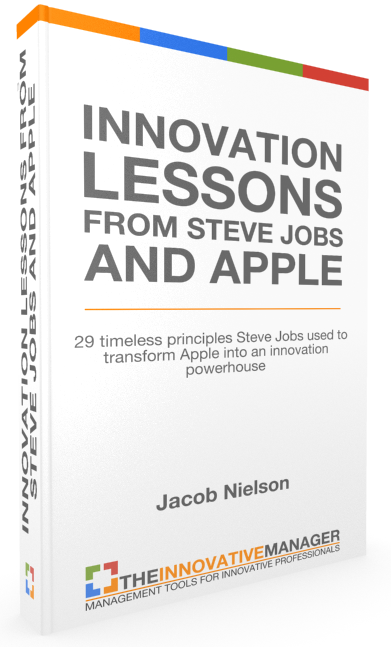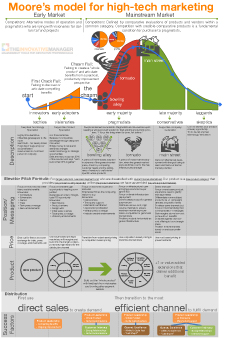Shortly after launching the iPhone, Steve Jobs famously said the following to Fortune Magazine:
These waves of technology, you can see them way before they happen, and you just have to choose wisely which ones you’re going to surf. If you choose unwisely, then you can waste a lot of energy, but if you choose wisely it actually unfolds fairly slowly. It takes years.
 The intriguing part of this quote is that Jobs said “You can see them [the technology waves] way before they happen.” If that’s the case, then why do so many firms often fail to react properly to impending waves of change when they come crashing on their industry? What could they have done to better prepare themselves and how? After reading this post, you’ll have the analysis tools you need to predict upcoming waves of change and be better prepared to surf them successfully.
The intriguing part of this quote is that Jobs said “You can see them [the technology waves] way before they happen.” If that’s the case, then why do so many firms often fail to react properly to impending waves of change when they come crashing on their industry? What could they have done to better prepare themselves and how? After reading this post, you’ll have the analysis tools you need to predict upcoming waves of change and be better prepared to surf them successfully.

FREE VIDEO TRAINING FOR INNOVATORS
Over 100 Slides Free and Downloadable as a PDF
Analyzing Technology Trends
When discussing technology waves, many people think of the technology “S” curve. This may have been what Steve Jobs had in mind when he gave his quote so I’ll provide a brief explanation. The Technology “S” curve illustrates three critical phases of a product or technology’s life cycle. These three phases are:
- Invent
- Commercialize
- Harvest
I won’t go into each in detail but the brief explanation is that each product takes time in the beginning to get to the point of becoming useful for a market of consumers. This “invent” time period can take a long time, often several years. But it is the most important time in a product’s life because any incorrect assumption regarding the idea can lead to its certain doom – even if the idea held massive untapped potential.
The next phase is commercialization. This mostly involves communication and support of the new product after it’s initial launch. Any time somebody invents something useful, they must put in the time to communicate its existence and its usefulness to the intended market or else the product will fail.
The last phase is harvest. In this phase, the product is widely recognized and well-received but there is very little room for additional growth. Some companies will divest themselves of these types of products in order to invest in others while other companies will cling on to these products until the bitter end.
From an innovation perspective, I would argue that the two phases encompassing the process of innovation are the invent phase and the commercialization phase together. The term innovation implies usefulness and broad acceptance rather than just invention. The invention enables usefulness while commercialization enables broad acceptance. From this we can construct this simple definition of innovation:
Innovation = Invention + Commercialization
 By using the technology S Curve, one can identify where along the curve a particular product or technology lies. This is helpful for when deciding what types of markets or industries to enter into. For example, the standard PC is arguably near the top of the curve and may soon go into decline. This being the case, it’s probably not a good idea to start a new PC company right now.
By using the technology S Curve, one can identify where along the curve a particular product or technology lies. This is helpful for when deciding what types of markets or industries to enter into. For example, the standard PC is arguably near the top of the curve and may soon go into decline. This being the case, it’s probably not a good idea to start a new PC company right now.
On the other hand, smartwatches and wearables are neck deep in the invent phase and are nearing commercialization. This could be a very promising product category to get into thanks to the future potential of these products being widely adopted in the near future.
Smartphones are probably in the commercialization phase right now and though many smartphone companies have struggled recently (e.g. HTC), according to many analysts, there is still room to grow within the market.
In my experience, the technology S Curve is a powerful tool for analyzing technology trends. But technology trends alone don’t necessarily tell the whole story. This is where industry trend analysis can help.
Industry trend analysis is is not new but over the years our understanding of its underpinnings has been greatly enhanced thanks to Michael Porter and Clayton Christensen. With Clayton Christensen’s work on disruptive innovation, the analysis tools available to entrepreneurs and large business managers can help innovators predict the type and magnitude of industry trends about to crest and enable them to create innovations specifically designed to capitalize on those trends.
To explore this in more detail, you first must know what types of products are prevalent in an industry. Broadly speaking, I like to think there are two types of products within an industry:
- Integrated
- Modular
Integrated Products
Integrated products are those that are specifically designed with multiple proprietary components that work together as a cohesive whole. For example, Apple has always been driven by the idea that they must control the entirety of the hardware, software and user experience with a product in order for it to meet their brand promise to consumers. Steve Jobs famously said regarding the MacBook Air:
There’s no other company that could make a MacBook Air and the reason is that not only do we control the hardware, but we control the operating system. And it is the intimate interaction between the operating system and the hardware that allows us to do that. There is no intimate interaction between Windows and a Dell notebook
Integrated products are usually demanded by consumers who are generally unsatisfied with the performance of several currently available products. For example, those who purchase a MacBook Air over a Dell notebook are more willing to pay a premium price in order to receive premium benefits such as a thin profile, speed, aluminum unibody, etc.
Modular Products
Modular products are those that are specifically designed with interdependent components assembled together. In the case of a Dell computer, in order for their computers to be as low cost as possible, Dell sought to outsource each component of the computer to the lowest-cost producer. This approach led Dell down the path of championing a modular computer architecture and helped fuel their growth during the late 90’s and into the early 2000’s.
Unlike integrated products, modular products are usually demanded by consumers who are generally satisfied, or in some cases overly satisfied, with the performance of the currently available products. This is why low-cost becomes so important. In general, someone who purchases a Dell over an Apple notebook is doing so because they are satisfied with the performance of the Dell and are not willing to pay a premium for the added benefits of an Apple product.
Waves of Change In the Consumer Electronics Industry
During the 90’s and into the early 2000’s, Dell’s product strategy was well suited to capitalize on the trend of modularity that Microsoft helped usher into the PC industry. Prior to the Microsoft Windows revolution, IBM created fully integrated products that they could sell for healthy margins. However, MS Windows changed the composition of a PC from an entire vertically integrated unit to essentially a box of modular hardware enabled by MS Windows. This shift helped drive down the cost of PC’s in general and siphoned industry profits away from vertically integrated hardware manufacturers (such as IBM) towards Microsoft and manufacturers that could achieve low-cost production such as Dell and HP. This shift toward commoditization of PC hardware, was the primary impetus for IBM’s exit from the PC industry in 2004 when they sold the business to Lenovo. It simply became too difficult for IBM to compete against the cost structure of Dell and HP.
Part of why this shift took place is because in the late 80’s and early 90’s consumers were generally satisfied with the performance of PC’s but were unsatisfied with the price. At that time, it was common for PC’s to cost upwards of $3000 for a basic computer. When Apple launched the first Macintosh in 1984, it’s introductory price was $2500. With those kinds of prices, it’s no wonder the cost effective architecture of Microsoft and low-cost hardware manufacturing won the initial PC versus Mac battle.
Fast forward to the mid to late 2000’s when we started to see the tide changing again in the consumer electronics industry from modularity back to vertical integration. With the return of Steve Jobs to Apple, several vertically integrated devices were launched with the specific intent to provide a more polished experience over the cost-sensitive PC’s of the day. When the Macbook Air (in addition to the Macbook pro which had been available for several years) was announced in 2008 as the world’s thinnest laptop, consumers began to value high performance in a computer again and were willing to pay the premium.
Apple’s vertical integration then led them to the introduction of several devices that only a vertically integrated firm could produce at the time – the iPhone and the iPad. These devices were breakthrough innovations that heralded the consumer electronics industry into a period where vertically integrated products could provide the best value proposition for consumers. This shift toward vertical integration is well underway with Google’s acquisition of Motorola‘s hardware business and with Microsoft’s acquisition of Nokia‘s mobile business. Both Google and Microsoft have come to the conclusion that at least for a time there is significant value to be created by being a vertically integrated firm. At some future date though, the tide will inevitably shift back towards modularity and the cycle will repeat itself.
Spotting and Surfing The Right Wave
So as innovators, our job is to see the future and capitalize on it with the introduction of products and services with a high probability of success. One way to predict the future is by observation of the cycle we’ve discussed above:
Integration –> Modularity –> Integration –> Modularity
During periods of integration, it is ideal to be an integrated firm and to develop products that are benefit focused and user experience optimized. During periods of modularity, it is ideal to be a modular firm that is cost focused and low price optimized.
Also, before making substantial investments it’s important to know how far an industry has gone into each phase. For example, if an industry is toward the end of an integration phase and consumers are starting to become fed up with high prices, it’s best to be positioned in a way that enables modularity – such as Microsoft was positioned in the mid 80’s. Conversely, if an industry has been modular for quite some time and there are signs from consumers that they expect more benefits out of the products that industry produces, then it would be best to provide an integrated solution. This is what Apple did in mid 2000’s.
To further this discussion, let’s take the TV content industry as an example. With the advent of YouTube, online video and pay-per show content distribution models, the television industry is entering into a period of modularity. The old days of vertically integrated TV providers such as NBC, CBS and ABC deciding what and when we can watch something is coming to an end. Not only this but also the price of access to cable TV content is dropping dramatically thanks to low cost subscription websites such as Hulu, Netflix and Amazon.
As the industry moves further toward a modular structure, the old vertically integrated firms will struggle to compete. But as the cycle predicts, after going through a period of modularity, someday the television industry may revert back to integration. But it could be a while before that happens.
Conclusion
In conclusion, this industry analysis framework can be used to analyze and predict the probability of success for your new business idea. If you design your new innovations in such a way to capitalize on these industry shifts, your success rate can dramatically improve.

















2 Responses to "How to Innovate by Capitalizing on Technology and Industry Trends"